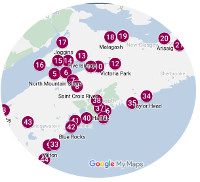- Why Mining Matters
- Jobs
- Safety
- Environment & Operations
- FAQ
- Links
- Fun Stuff
Peggy's Cove
The geological history of Peggy’s Cove started over 470 million years ago in an ocean basin near ancient Africa. Mud and sand gathered in the basin and were, over time, compressed into rocks called shale and sandstone. Tectonic plate movement brought the basin around the world to ancient North America where the plates collided.



Heat generated by the colliding of the tectonic plates melted rocks at the base of the earth’s crust 370 million years ago. The resulting molten material, or magma, rose to within several kilometres of the earth's surface, cooled and solidified into granite. It was later exposed as a result of uplift (mountain building) and the erosion of kilometres of rock above it.
About 350 million years ago, when Nova Scotia was tropical, the sea moved into low-lying areas and created St. Margaret's Bay, which is adjacent to Peggy’s Cove.
10,000-70,000 years ago, most of Nova Scotia was covered by glacier, several kilometres thick. The ice scratched and gouged the granite and left boulders, rocks and sand behind.
All this geological activity over hundreds of millions of years gave us the Peggy's Cove we know today.

Erratics are rocks moved by glaciers that often look out of place - because they are! Glaciers carry rocks as they move and deposit them as they melt.
The name comes from the Latin word errare, meaning “to wander.” The Peggy’s Cove area has many erratics from the last ice age.
Further reading: https://novascotia.ca/natr/meb/data/pubs/ic/ic09.pdf




























































































